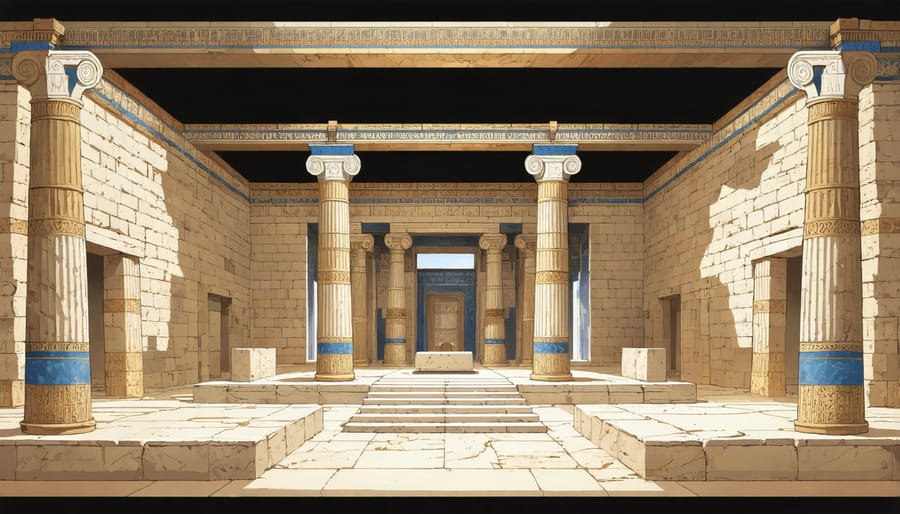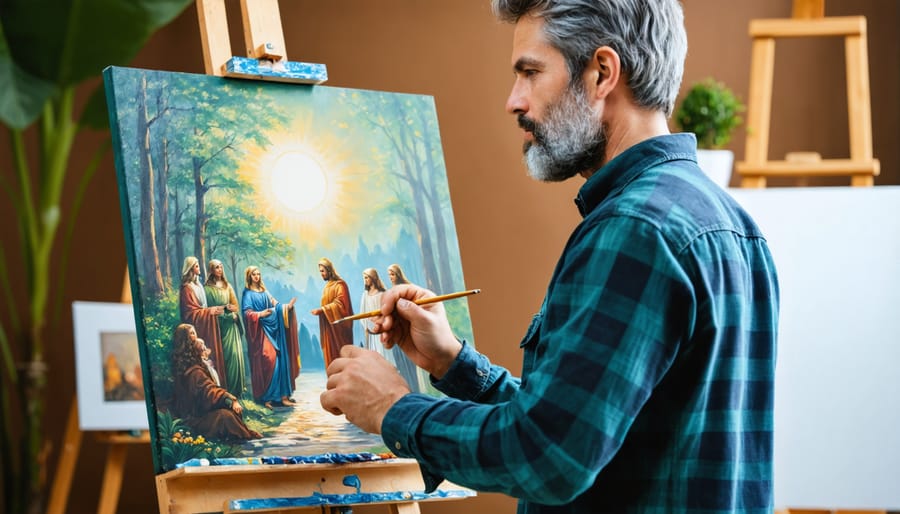Art has served as a divine language throughout biblical history, weaving God’s story into the fabric of human creativity. From the intricate designs of the Tabernacle to Solomon’s Temple, artistic expression has been a powerful vessel for spiritual truth and divine revelation. “For we are God’s handiwork, created in Christ Jesus to do good works” (Ephesians 2:10), reminds us that creativity itself flows from our identity as image-bearers of the Creator.
This sacred connection between art and faith transcends mere decoration, embodying profound theological truths and serving as a bridge between the divine and human experience. In biblical times, art wasn’t just aesthetic—it was prophetic, instructional, and worshipful. Through carefully chosen colors, symbols, and materials, artists conveyed deep spiritual meanings that continue to resonate with believers today.
As we explore the biblical meaning of art, we discover a rich heritage that invites contemporary Christians to embrace creativity as a form of worship, ministry, and spiritual expression.

The Divine Origin of Creativity
Made in His Image: Our Creative Heritage
Genesis 1:27 tells us that God created humans in His own image, and this profound truth extends to our inherent creative abilities. As image-bearers of the ultimate Creator, we are uniquely endowed with the capacity to imagine, design, and bring beauty into the world. This gift of divine creative inspiration reflects our spiritual DNA as God’s children.
When we create art, whether through painting, music, dance, or any other medium, we participate in a sacred echo of God’s own creative nature. This creative impulse isn’t merely a hobby or talent; it’s a fundamental aspect of our spiritual identity. Just as God spoke the universe into existence and crafted every detail of creation with purpose and beauty, we too are called to contribute to the world’s beauty through our artistic expressions.
This creative heritage serves as both a blessing and a responsibility, inviting us to use our artistic gifts to glorify God and inspire others in their faith journey.
Biblical Examples of Sacred Artists
The Bible showcases several divinely appointed artists who used their creative gifts to glorify God. Most notably, Bezalel and Oholiab were specifically chosen by God to create the magnificent artworks for the Tabernacle. In Exodus 31:1-6, God declares that He filled Bezalel with His Spirit, giving him wisdom, understanding, and skill in all kinds of crafts – working with gold, silver, bronze, stone, and wood.
These master craftsmen not only created beautiful works but also taught others, establishing what could be considered the first biblical school of sacred arts. Their work included intricate embroidery, metalwork, and woodcarving, demonstrating that God values artistic excellence and diverse creative expressions.
Other biblical artists include the skilled craftsmen who adorned Solomon’s Temple and the musicians who composed psalms. King David himself was not only a warrior and leader but also a poet and musician who wrote many of the Psalms, showing how artistic expression can be a powerful form of worship and prophetic declaration.
Art as Worship in Scripture
Temple Art and Sacred Spaces
God’s detailed instructions for both the Tabernacle and Solomon’s Temple reveal the profound significance of sacred art in worship. The Tabernacle featured intricate embroidery of cherubim on blue, purple, and scarlet curtains, symbolizing the meeting place between heaven and earth. Gold-covered cherubim spread their wings over the Ark of the Covenant, representing God’s divine presence and protection.
Solomon’s Temple elevated sacred artistry to new heights, incorporating elaborate wood carvings of palm trees, flowers, and cherubim throughout its chambers. The massive bronze pillars, Jachin and Boaz, stood as masterful symbols of God’s strength and stability. The Temple’s walls shimmered with pure gold overlay, while precious stones added radiant beauty, reflecting God’s glory and majesty.
These sacred spaces demonstrate how God values excellence in craftsmanship and beauty in worship. The artisans Bezalel and Oholiab were specifically filled with God’s Spirit to create these works, showing that artistic ability is a divine gift. Every artistic detail served a purpose: to inspire reverence, facilitate worship, and remind God’s people of His holiness and presence among them. These ancient sacred spaces continue to inspire modern church architecture and worship aesthetics.

Music and Dance in Biblical Worship
Music and dance played vital roles in biblical worship, serving as powerful expressions of devotion, celebration, and spiritual connection. Throughout Scripture, we find numerous examples of these performing arts being used to glorify God. King David, known for dancing before the Lord with all his might (2 Samuel 6:14), demonstrated how physical movement could be an authentic expression of worship.
The Psalms frequently mention musical instruments, singing, and dancing as integral parts of worship. “Praise him with tambourine and dance; praise him with strings and pipe!” (Psalm 150:4) reveals the diverse ways ancient believers used performing arts in their worship practices. The temple worship included trained musicians and singers, highlighting the importance of excellence in artistic expression.
Music held both ceremonial and spiritual significance, with instruments like the harp, lyre, and trumpet accompanying various religious ceremonies. The Book of Chronicles describes how King David organized over 4,000 musicians for temple worship (1 Chronicles 23:5). These artistic expressions weren’t merely performances but were considered offerings to God, demonstrating how the performing arts can deepen our connection with the divine and unite believers in corporate worship.
Today, these biblical examples continue to inspire contemporary worship practices, reminding us that artistic expression remains a meaningful way to honor God.
Art as Biblical Communication
Symbols and Visual Metaphors
Throughout history, biblical symbols in art have served as powerful tools for conveying spiritual truths. The lamb represents Christ’s sacrifice, while the dove symbolizes the Holy Spirit and divine peace. Artists often use light to represent God’s presence and wisdom, drawing from Scripture’s declaration that “God is light” (1 John 1:5). The fish, an early Christian symbol, reminds us of Jesus calling His disciples to be “fishers of men” (Matthew 4:19).
Colors also carry deep spiritual significance, with purple representing royalty and kingship, white symbolizing purity and holiness, and gold reflecting divine glory. The cross, Christianity’s most recognizable symbol, stands at the center of Christian art as a reminder of Christ’s redemptive work. Through these visual metaphors, artists have created bridges between the physical and spiritual realms, helping believers connect more deeply with biblical truths and making complex theological concepts accessible to all.
Making Scripture Accessible
Throughout history, art has served as a powerful tool for making biblical truths accessible to all people, regardless of their ability to read or understand different languages. In medieval times, stained glass windows and religious paintings acted as “visual Bibles,” allowing illiterate congregants to understand and connect with sacred stories. Even today, art continues to bridge cultural and linguistic gaps, making Scripture’s message universally understandable.
Visual representations of biblical narratives help people relate to God’s Word in deeply personal ways. When we see a painting of Jesus welcoming children or the Good Shepherd carrying a lost sheep, these images speak directly to our hearts, transcending barriers of language, education, and cultural background. As Psalm 78:6 reminds us, these truths are meant to be passed down “that the next generation might know them.”
Modern Christian artists continue this tradition by creating contemporary works that make biblical stories relevant and approachable for today’s audiences, ensuring that God’s message remains accessible to all who seek it.
Creating Art with Sacred Purpose

Finding Your Divine Inspiration
Creating art that honors God begins with seeking His guidance through prayer and meditation on Scripture. Just as God’s Spirit moved over the waters during creation, He can move through you as you create. Take time to quiet your heart and listen for His leading, allowing biblical themes and truths to inspire your work.
Consider how your artistic gifts can serve others and glorify God. Whether through painting, sculpture, music, or any other medium, ask yourself how your work can reflect God’s beauty, truth, and grace. Look to Scripture for inspiration – the Psalms offer rich imagery, while the detailed craftsmanship instructions for the Tabernacle demonstrate God’s appreciation for artistic excellence.
Stay rooted in community with other believers who can encourage and guide your artistic journey. Share your work with fellow Christians who can provide spiritual insight and accountability. Remember that your creativity is a gift from God, meant to be used for His purposes and the edification of His church.
As you create, maintain a humble spirit and remain open to God’s direction. Let your art become a form of worship, prayer, and testimony to His goodness. Focus on excellence while remembering that your worth comes from being God’s beloved child, not from your artistic achievements.
Using Your Gifts for God’s Glory
God has blessed each of us with unique artistic talents, and we are called to use these gifts to glorify Him and serve others. Whether through painting, music, dance, or other creative expressions, our artistic abilities can become powerful tools for ministry and worship.
One practical way to use your artistic gifts is by joining a creative arts ministry in your local church. These ministries often need talented individuals to help with worship banners, stage design, multimedia presentations, and special performances that enhance the worship experience.
Consider using your art to illustrate biblical stories for children’s ministry, create meaningful decorations for church events, or design materials for outreach programs. You might also share your faith journey through your artwork, using your creative process as a testimony to God’s grace and guidance in your life.
Remember 1 Peter 4:10: “Each of you should use whatever gift you have received to serve others, as faithful stewards of God’s grace in its various forms.” By dedicating your artistic talents to God’s purpose, you participate in His ongoing work of touching hearts and transforming lives through beauty and creativity.
Art in biblical context reveals God’s heart for creativity and beauty, serving as a powerful medium for worship, teaching, and expressing divine truth. As we’ve explored throughout this article, artistic expression holds deep spiritual significance, from the intricate details of the tabernacle to the poetic verses of the Psalms. God’s first introduction in Scripture is as the ultimate Creator, and He has graciously shared this creative nature with humanity, made in His image.
As believers, we are called to recognize and embrace our creative gifts as divine appointments for ministry and worship. Whether through painting, music, dance, or any other artistic medium, our creative expressions can glorify God and touch hearts in unique ways that words alone cannot achieve. The Bible affirms that our artistic abilities are spiritual gifts meant to edify the church and draw others closer to God.
Let us move forward with confidence, knowing that when we create with pure hearts and godly intentions, we participate in a sacred tradition that spans millennia. May we continue to use our artistic gifts to reflect God’s beauty, share His truth, and build His kingdom through creative expression.
